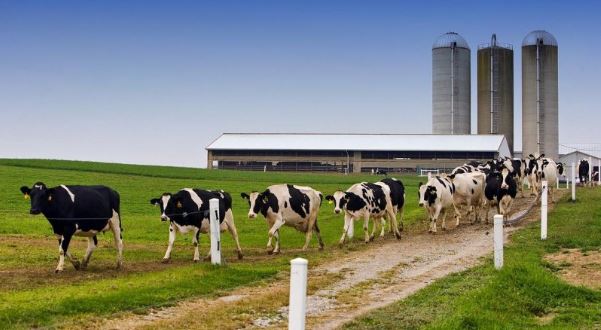
March 6 (UPI) — Recent outbreaks of illness in the United States are raising renewed concerns about selling and consuming raw milk and raw milk products.
While advocates have touted the nutritional value of unpasteurized milk, agencies like the U.S. Food and Drug Administration have continued to warn the public of associated risks with consuming it in any form.
Last month, the FDA urged consumers not to eat Raw Farm-brand Raw Cheddar — blocks and shredded — cheese products that the agency said was responsible for a multistate outbreak of E. coli O157:H7.
As of the end of February, the FDA said 11 confirmed infections were reported in five states — Utah, California, Colorado, New Jersey and Texas. Five patients were hospitalized, with two developing hemolytic uremic syndrome that can result in kidney failure. No one has died.
Raw Farm had recalled certain lots of the cheese Feb. 16, but withdrew the recall 10 days later after it said the FDA and state agencies found no pathogens or breaches in food safety protocols at its plant. The company maintained it had been “urgently pressured into the recall with no evidence.”
FDA said the investigation is ongoing.
Death in the U.K.
In another case linking raw milk cheese to illness, a person died last last year in the United Kingdom of Shiga toxin-producing E. coli 145 in an outbreak in which many of 30 patients with symptoms in England and Scotland ate unpasteurized cheese.
Regulators recalled four of Mrs. Kirkham’s Lancashire Cheese products as a precaution.
Raw milk is popular among those who want to eat natural products and believe pasteurization — a partial sterilization to destroy potentially harmful organisms — removes important nutrients.
Advocates of raw milk and raw milk products cite the advantage the enzymes, probiotics, healthy fats, proteins, vitamins and calcium that are not compromised by processing. And they note that stomach cramps, bloating and digestive discomfort sometimes come from processed milk.
In 2022, the FDA found that 4.4% of U.S. adults consumed raw milk at least once in the previous year, with 1.6% reporting consuming raw milk once per month and 1% doing so once a week or more often.
Selling and distributing raw milk across state lines has been prohibited since 1987 by FDA mandate. According to UCLA Health, 30 states allow raw milk sales and 20 prohibit it.
But even a decade ago, when unpasteurized milk was gaining popularity, scientists were warning against it.
Assortment of infections
In a study published in Emerging Infectious Diseases in 2017, researchers cited E. coli, salmonella, campylobacter and listeria that can emerge from contaminated cow’s milk.
They noted that “Unpasteurized products are consumed by a small percentage of the U.S. dairy consumers, but cause 95% of illnesses.” And, they said, the risk for illness was more than 800 times greater for those who use unpasteurized milk or cheese than for those who use pasteurized dairy products.
But because politicians often have a larger say over policy than scientists, an effort to allow raw milk in some states that ban its sale is ongoing.
For example, House Bill 4736, also known as the West Virginia Farm Fresh Dairy Act, would allow the sale and consumption of homemade and farm fresh raw milk and raw milk products, while “encouraging the expansion of raw milk dairy sales by small farm producers and accessibility of their products to informed end consumers.”
The bill also calls for the West Virginia Department of Agriculture to register and inspect small dairies for compliance.
In Colorado, Senate Bill 24-043 would allow raw milk producers to sell directly to consumers. The bill also would require dairy farmers to register with the Colorado Department of Public Health to do so.
Cautions cited
Dr. Charles Bailey, an infectious disease specialist in southern California, said that while he supports the freedom of consumers to make an informed choice among milk products for themselves and their families, he finds the FDA cautions more persuasive than advocacy by the raw milk industry.
Bailey said rebuttal facts posted on sites like RealMilk and the Raw Milk Institute fall short.
“I find the 2011 FDA document on raw milk misconceptions and dangers to be a robust and persuasive detailing of the situation and am aware of nothing in the past decade plus to detract from this opinion,” he told UPI.
“These [raw milk advocates] seek to provide point-by-point rebuttal to the FDA position, but fall short of furnishing convincing evidence either that raw milk has significant scientifically demonstrable benefits over pasteurized cow’s milk or is a safer choice.”
On the other side of the coin, Dr. Jeremie Walker, an anesthesiologist, said he is passionate about raw milk. A provider with California’s Opt Health, Walker said raw milk has been picking up steam as consumers consider its benefits.
“The entire food system has been hijacked since the Industrial Revolution at the expense of our health and for the profits of big business. Raw milk only acquired a bad rap when we mistreated our animals in crowded developing inner-city “distilleries” leading to sick animals,” Walker told UPI.
“Pasteurization obliterates or damages so many of the critical elements in raw milk that make it so nutrient dense like the bioactive enzymes and immunoglobulins.”





